Methyl cellulose is a water-soluble polymer made from cellulose. It is used as a thickener, emulsifier and stabilizer in foods and cosmetics. HPMC is a water-soluble polymer made from cellulose modified with hydroxypropyl groups. It is used as a thickener, emulsifier and stabilizer in foods, pharmaceuticals and cosmetics. Both methyl cellulose and HPMC are widely used and have a variety of applications. However, HPMC is more commonly used in building materials than methyl cellulose.
In the formulation of dry mortar in the building materials industry, the use of cellulose-based polymers is common. In fact, cellulose-based polymers are essential additives for formulations such as tile adhesives, wall fillers, ETICS/EIFS and others.
If you’re looking for cellulose ethers as a functional additive in your dry mortar mixes, you may be wondering about the differences between hydroxypropyl methyl cellulose (HPMC) and methyl cellulose (MC). Both HPMC and MC are cellulose-based polymers derived from plant cellulose. They’re non-toxic, biodegradable and non-carcinogenic. So what’s the difference between them? In this article, we’ll explore the key differences between HPMC and MC and help you decide which one is right for your needs.
What is Methyl Cellulose?
Methyl cellulose is a water-soluble polymer made from cellulose. It is used as a thickener, emulsifier, and stabilizer in food and cosmetics. Methyl cellulose is created when cellulose is treated with hydrochloric acid. The end result is a substance that is white, odorless, and tasteless. It has a wide range of uses, including as a thickener (as a substitute for cornstarch), a stabilizer (to prevent ingredients from separating or settling), a binding agent (to hold ingredients together), or an emulsifier (to blend two substances that don’t dissolve well in each other).
What is HPMC?
HPMC (Hydroxypropyl methyl cellulose) is a water-soluble polymer made from cellulose modified with hydroxypropyl groups. It is used as a thickener, emulsifier and stabilizer in foods, pharmaceuticals and cosmetics. HPMC is produced by treating methyl cellulose with propylene oxide. The end result is a white, odorless and tasteless powder. Hydroxypropyl methyl cellulose is very similar to methyl cellulose, but it is more soluble in water and has a higher viscosity. HPMC has many uses, such as a thickener (to replace cornstarch), a stabilizer (to prevent ingredients from separating or settling), a binder (to hold ingredients together), or an emulsifier (to mix two substances that do not dissolve well into each other).
The Difference between Methyl Cellulose and HPMC
Methyl cellulose and HPMC are both cellulose-based polymers, meaning they are nearly identical in chemical composition and structure. The main difference between the two is that HPMC has been modified with hydroxpropyl groups. HPMC is more water soluble and is therefore used in more industries than methyl cellulose. Methyl cellulose is more commonly used in food and cosmetics, while HPMC is more commonly used in pharmaceuticals and construction. In terms of application, however, there is very little difference between methyl cellulose and HPMC.
HPMC is commonly used in building materials such as tile adhesives, plasters, and lightweight drywall. HPMC is generally more widely used and more expensive than methyl cellulose. However, HPMC has a number of advantages that are worth the price. These include better solubility, higher viscosity, better water retention, Ph stability and resistance to high temperatures. It is important to consider these differences when deciding which product is right for your needs.
Conclusion
Methyl cellulose and HPMC are two types of cellulose-based polymers commonly used in building materials. However, Methyl Cellulose is gradually being replaced by HPMC due to the higher requirements in modern construction. In addition, some suppliers refer to methyl cellulose as the common name for hydroxypropyl methyl cellulose (HPMC) and Hydroxyethyl methyl cellulose (HEMC). We will explore the difference between HPMC and HEMC in later articles.
